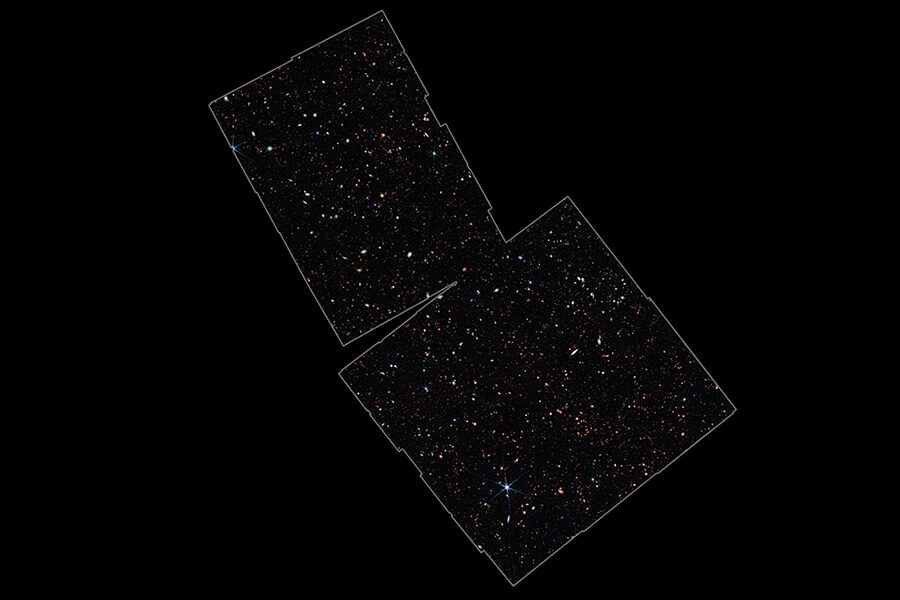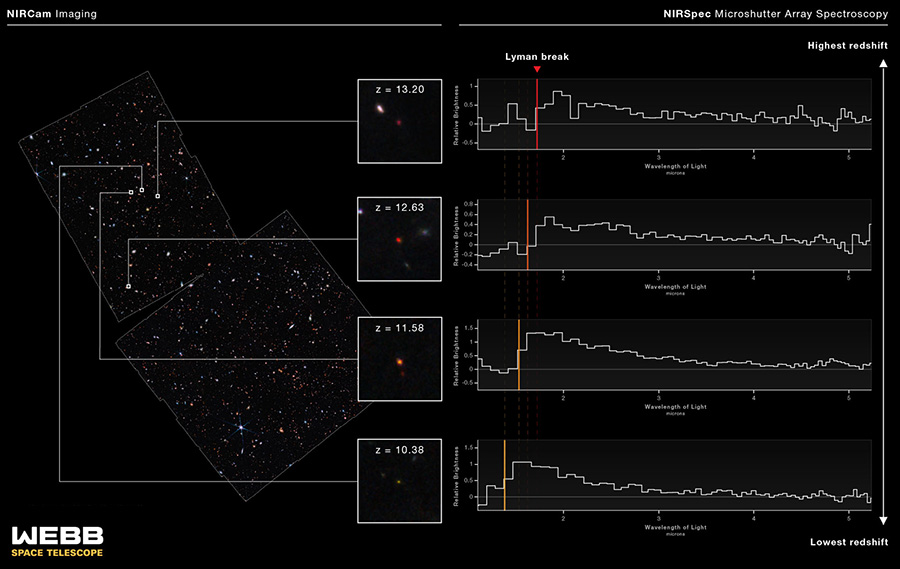Spectroscopic measurements confirm Webb’s distance record, with images revealing galaxies that existed just 330 million years after the Big Bang.
Update (April 4, 2023):
This work has now been published in Nature Astronomy.

Image credit: NASA / ESA / CSA / M. Zamani (ESA / Webb); Science: B. Robertson (UCSC) / S. Tacchella (Cambridge) / E. Curtis-Lake (Hertfordshire) / S. Carniani (Scuola Normale Superiore) / JADES Collaboration.
Astronomers using the James Webb Space Telescope (JWST) have confirmed the most distant galaxies ever observed. Some formed just 330 million years after the Big Bang, when the universe was a mere 2% of its current age.
These new results, based on highly detailed spectroscopic measurements, provide concrete distances to galaxies first revealed in Webb images. “It was crucial to prove that these galaxies do, indeed, inhabit the early universe,” says Emma Curtis-Lake (University of Hertfordshire, UK). “It’s very possible for closer galaxies to masquerade as very distant galaxies.”
Curtis-Lake is part of a group of 80 astronomers from 10 countries behind the JWST Advanced Deep Extragalactic Survey (JADES). They've been given a total of a month's observing time, spread over two years, to look at the spectra of distant galaxies. The first part of this effort saw them observe an area of the night sky in and around the famous Hubble Ultra Deep Field (HUDF). (The team is in the process of publishing this data; although the study has not yet passed peer review, NASA has made it available here.)
Spectra of distant galaxies have a distinct cut-off point called the Lyman break, caused by intergalactic hydrogen absorbing wavelengths shorter than 91.2 nanometers on its journey towards Earth. Yet the ongoing expansion of the universe stretches the wavelength of light from these galaxies in the early universe, which in turn shifts their Lyman break to longer wavelengths, too. The longer the wavelength at which a galaxy appears to drop off in brightness, the older and more distant it is.
The Lyman break can be seen in broadband images at multiple wavelengths, which is how astronomers first pinpointed these galaxies. However, galaxies may appear to “drop out” at shorter wavelengths for other reasons, such as veils of dust created by bursts of star formation. Spectroscopic measurements fill in the gaps, providing additional data that can confirm that a drop in brightness is indeed due to the galaxies’ extreme distance.
The JADES team collected 28 hours of data on 253 different galaxies using Webb's Near Infrared Spectrograph (NIRSpec) instrument. They hit the jackpot with four of them. The location of their Lyman breaks suggest that they are all beyond redshift 10. Two of them have a redshift of 13, meaning they formed as early as 330 million years after the Big Bang.

Image credit: NASA / ESA / CSA / STScI / M. Zamani (ESA/Webb) / L. Hustak (STScI); Science: B. Robertson (UCSC) / S. Tacchella (Cambridge) / E. Curtis-Lake (Hertfordshire) / S. Carniani (Scuola Normale Superiore) / JADES Collaboration.
These ancient galaxies form part of a newly released image of the HUDF area taken with Webb's Near Infrared Camera (NIRCam) using nine different wavelengths of infrared light. Blue in the image represents light at 1.15 microns, green is 2.0 microns, and red is 4.44 microns.
“To find these early galaxies in such stunningly beautiful images is a special experience,” says team member Brant Robertson (University of California, Santa Cruz).
Studying these distant galaxies is a crucial part of working out how we arrived at the universe we see today. “It is hard to understand galaxies without understanding the initial periods of their development,” says team member Sandro Tacchella (University of Cambridge, UK). “As with humans, so much of what happens later depends on the impact of these early generations of stars. So many questions about galaxies have been waiting for the transformative opportunity of Webb, and we're thrilled to be able to play a part in revealing this story.”
Michael Strauss (Princeton University), who was not involved in the research, is excited to see the results. “It is completely amazing that we are measuring spectroscopic redshifts for galaxies at redshift of 13, looking back to the first few hundred million years of the universe’s history,” he says. “We’re just starting to probe what is often called the ‘Cosmic Dawn’ with these observations, and who knows what the next year — much less the next 20 years — with JWST will teach us.”
If this is the appetizer, we may not have to wait long for the next course. JADES will continue in 2023 with a detailed study of the Hubble Deep Field, before returning to the Ultra Deep Field for another round of imaging and spectroscopy. These new distance records could easily be broken as astronomers probe further and further into the universe's youth.
 3
3









Comments
Martian-Bachelor
December 16, 2022 at 11:41 pm
Back in July there was mention of a photometric redshift of z ~16.7 for a galaxy. Has that galaxy been hit with the spectrograph yet?
Also, a pet peeve of mine: the redshifts represent actual measurements, whereas phrases like "formed just 330 million years after the Big Bang" are in fact model-dependent, something which is never mentioned. I think the distinction is important.
The only thing we can be certain of is that the universe has expanded by a factor of z since the light left the object, assuming that's the sole cause of the redshift. Things like distance, look-back time, and age of the universe at the time of emission are, like I say, model-dependent and therefore subject to change, whereas z won't change unless there was a flub in the ID of the lines measured or something like that.
You must be logged in to post a comment.
Monica Young
December 19, 2022 at 10:13 am
Hi Martian-Bachelor,
Good question! That redshift 16.7 galaxy (CEERS-93316) was later revised down to "only" 16.4. As far as we are aware, this has not yet been spectroscopically confirmed, but the CEERS program under which this galaxy was imaged does plan to do spectroscopic follow-up, so assuming there are no problems with being able to take the object's spectrum, it's only a matter of time.
At Sky & Telescope, we do strive to give redshifts in addition to lookback time, but it's worth noting that lookback time is more intuitive for readers to help place new information. True, it's model-dependent; however, that model hasn't changed significantly in years. You can always use this cosmology calculator to help translate between the two: https://astro.ucla.edu/~wright/CosmoCalc.html. (Sky & Telescope uses H0=69.6, Omega_M=0.286, and Omega_vac=0.714.)
You must be logged in to post a comment.
lwbehney
December 25, 2022 at 4:35 pm
I would like to know if these ancient galaxies differ significantly from presumably more mature galaxies with perhaps redshifts with Z < 10? If so, are the stars generally more massive in that time, or does the presumed lack of dust make cold molecular cloud formation more difficult? Any population III star sightings? Thanks very much. These are exciting times in astronomy, thanks to this wonderful JWST!
You must be logged in to post a comment.
You must be logged in to post a comment.